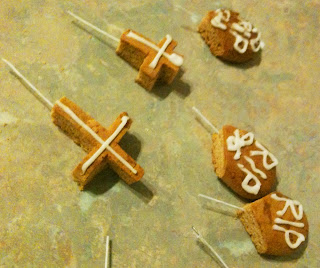I see no reason why gunpowder treason should ever be forgot....
Well, that's the rhyme I grew up with, and it's about poor old Guy Fawkes who, it seems, was actually innocent, and didn't in fact plot to blow up the Houses of Parliament. Being a rebellious left-winger who no doubt would have got on famously with Mr Fawkes, I decided to help him along a bit by creating light-up bomb cupcakes for the fifth of November this year:
They were carrot and walnut cakes topped with cream cheese icing, then decorated with an irregular red 'boom' kind of fiery explosive pattern and topped by a big block bomb....
....Which had a sparkler for a fuse, and lit up spectacularly!
I'll get to the cake and icing recipes later, but let's start with the (very simple) process for decorating!
I mixed up some red fondant using gel colour. This is the gel colouring being put on and shows the quantity I used relative to the pize of the fondant piece. I kneaded this until it was a solid red, then broke off a little bit and added yellow colour to get a more orangey shade. Then I kneaded them together lightly to try to get a reddish-orange marbled effect.
As you can see, the marbling didn't really work - the colours weren't different enough. However, I rolled it out and began cutting roughly star-shaped pieces out of it. This was meant to sit underneath the bomb, to give an impression of a fire starting underneath (it also gave the cupcake a touch of colour which it really needed).
This picture shows you the dreadful mess that in the end involved the entire bench, floor and the front of my clothes. However, I did manage to get twelve red stars out of it.
These went onto the tops of the cupcakes and I stuck them down with a bit of water. I also 'painted' the tops of them with water, which is a bit of a no-no usually, because the colour is liable to run and the surface becomes sticky, but I had got so much cornflour on the surfaces during the process of rolling and cutting that they looked really dusty and this cleaned them up.
Then it came to making the bombs. I bought a ready-coloured black fondant for this, because I HATE mixing black fondant - it takes ages and leaves black smudges all over everything.
I hand-rolled balls of black fondant about the size of a big marble...
....Until I had twelve of them, one for each cupcake.
Then I rolled a long sausage of the black fondant and cut it into small cylindrical lengths. I stuck one on each bomb - this is the little bit of the bomb where the fuse attaches.
(I know nothing about bombs, so I have no idea if that is actually right, but this is what I imagine when I picture an old-fashioned bomb.)
The next stage was the sparkler 'fuse'. Obviously, sparklers are a bit long for a fuse of this size so I needed to trim them down. REAL TOOLS (i.e., a pair of pliers) were required for this step....
....And for the next step, which was to trim the top end of the sparkler (the bit that sparkles). I did this very carefully, away from any food, and made sure there were no 'sparkler' crumbs that fell onto the cupcakes - I know they're often stuck onto cakes, but I'm pretty sure they're not supposed to be eaten.
(Safety note: when trimming/using/disposing of the remainders of the sparklers, remember they are flammable and don't place near open flames.)
The cut-down sparklers can then be pushed gently into the bombs' 'fuse receptors'...
...Until you end up with something like this.
I liked my little bombs all lined up and ready to explode.
 The finished result.....
The finished result..... ...And again, on a cupcake stand...
....And when the fuse is lit.... voila!
Recipe for carrot and walnut cupcakes with cream cheese icing
Ingredients:
225g plain flour
3/4 tsp baking powder/bicarb soda
2 large eggs
100g light brown sugar
pinch of salt
175ml vegetable oil (I used sunflower oil)
150g carrots (approx 2 medium size carrots), grated finely
200g walnuts
zest of one lemon
zest of 1/2 orange or mandarin
Icing:
125g cream cheese
250g icing sugar
Squeeze of lime or lemon juice, to taste
Set the oven to 180C and line a cupcake tray with cupcake papers.
Beat the sugar and the vegetable oil together with an electric mixer, then add the eggs, one by one, and beat again.
This is the mixture with the eggs added and beaten in.
Stir in the flour, baking powder and salt...
...Then grate the carrots finely - I use a microplane grater because they are fast and get a great, very fine grate.
Chop the walnuts roughly and gently stir in the grated carrot and walnuts.
Then zest the lemon and orange.
I was finding the orange extremely difficult to zest, with very little zest actually making it through to the other side of the zester. This bewildered me....
... Until I realised that I had been 'zesting' a small oval sticker that had been on the skin of the orange.
Way to go, food producers that put stickers on fruit.
Stir in the zests and spoon the mixture evenly into the cupcake cases. Bake for 20 minutes or until golden and a skewer stuck into the centre of a cupcake comes out clean.
For the icing, combine the icing sugar and cream cheese with a fork or beaters, then add some lemon or lime juice to get the consistency and flavour you want.
That's it for the cupcakes for today!
Happy Guy Fawkes Day from Dr Cupcake!!




























































